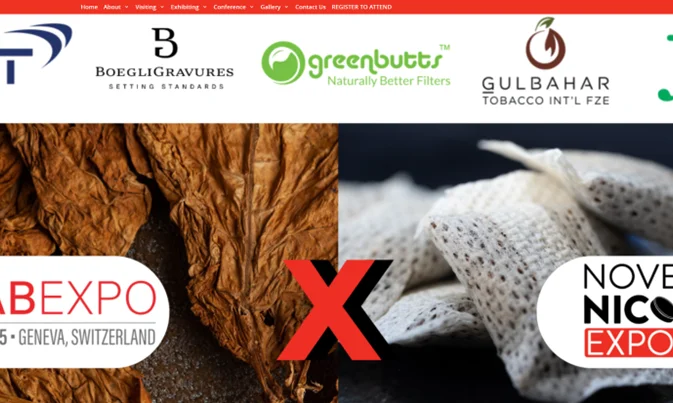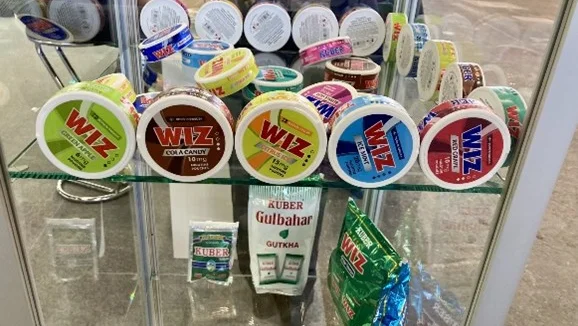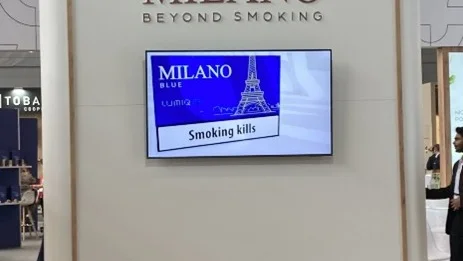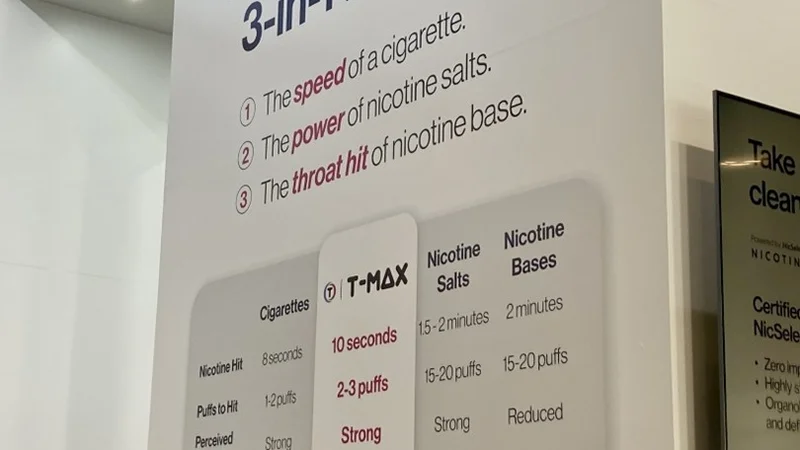- 12.06.2025
- News
- Blog
Behind the Scenes at TABEXPO 2025: How the Tobacco Industry Shapes Its Future
On May 8 and 9, 2025, Geneva hosted the 30th edition of TABEXPO, one of the largest European trade fairs for the tobacco and nicotine industry. Held at Palexpo, this international event was hoping to attract around 3,000 visitors and approximately 100 exhibitors to discuss innovation, regulatory challenges, alternative products, and global sustainability strategies.
Billed as the largest B2B (business-to-business) conference in the sector, TABEXPO 2025 also featured a “Novel Nicotine Expo” fully dedicated to new nicotine-containing products. Both events were organized by Quartz Business Media, which also manages shisha trade shows.
The official tone is crystal clear: “Innovating for the future of the tobacco industry.” The introduction highlights Switzerland’s central role in this field: “Switzerland is home to the world’s largest tobacco companies. Philip Morris International (PMI), British American Tobacco (BAT), and Japan Tobacco International (JTI) have long operated in the country, with regional headquarters, research centers, and manufacturing facilities spread throughout.” No surprise, then, to find BAT and JTI among the main sponsors of the 2025 edition.
What the public doesn't always see is what happens behind the scenes. A former tobacco industry insider — who wished to remain strictly anonymous — attended TABEXPO 2025 as a critical observer. Thanks to their insights, we were able to document from within how the industry is shaping its future. In their words, this is no ordinary trade show: “TABEXPO is a strategic showcase, where the blueprint for the next wave of addiction is drawn.”

From Showcase to Stage: The Tobacco Industry on Display
In two halls of Palexpo, TABEXPO 2025 took on the appearance of a high-tech fair, where the world of nicotine was presented at its most polished and sophisticated. The carefully designed booths, adorned with slogans about innovation, sustainability, and “harm reduction,” featured a polished array of products designed to perpetuate nicotine use in other forms: e-cigarettes, heated tobacco — and above all, nicotine pouches. These were the star of the “Novel Nicotine Expo,” making up about half of all products showcased in Geneva. Colorful boxes filled with flavored pouches in varying nicotine strengths were prominently displayed, their packaging tailored to appeal to all market segments. One Estonian manufacturer even offered visitors the chance to create their own brand.


Nicotine pouches of every color and flavor imaginable, offered by brands from all over the world.
Exhibitors aimed to entice professionals seeking partnerships and solutions for the evolving global nicotine market. Under the guise of innovation, the real agenda was product diversification and market expansion. The message was clear: nicotine still has a future — as long as its form evolves.
Alongside the exhibitor booths, conferences featuring industry “experts” speaking on regulatory threats and market opportunities were held over the two days of the event. The speakers at TABEXPO 2025 perfectly embodied the industry’s internal dynamics. These experts included corporate scientists from major tobacco multinationals pitching products supposedly less harmful than cigarettes. One also heard from consultants specializing in regulatory strategy and investor relations, and active in the global repositioning of the nicotine giants, describing the political considerations involved in the acceptability of these products in different markets. Other experts were from laboratories commissioned by the tobacco and nicotine industries, bringing a veneer of technical neutrality to debates on quality or safety.
The talking points are well honed: innovation, science, balanced regulation, sustainability. However, they mostly serve to distort any public debate, to impose favourable assessment frameworks, and occupy decision-making spaces. These experts — scientists, consultants, market analysts — lend technical legitimacy to an industry seeking respectability. They contribute to crafting a simple narrative – one of a industry in transformation – yet one that still insists on writing its own rules. TABEXPO is not just a trade fair. It is a strategic crucible of narrative and power, wherein the international nicotine industry seeks to forge anew its role, its legitimacy and its future growth opportunities.
The Industry’s Future: Diversification and Conquest
“Alternative products are the future; traditional cigarettes are becoming a thing of the past.” With this declaration, the chief analyst for Euromonitor International’s Nicotine and Cannabis division opened his conference at the 30th TABEXPO in Geneva [1] . Euromonitor is a global market research company that provides trend analysis and consulting for major players such as Philip Morris International (PMI), British American Tobacco (BAT), Imperial Brands, and Japan Tobacco International (JTI), as confirmed on Euromonitor’s website.
The stated goal is clear: “Multiply the variety of products available to consumers.” Big Tobacco is keen to diversify its portfolio — vapes, nicotine pouches, a variety of flavors, hybrid devices. The tobacco industry believes a single mode of consumption is no longer sufficient to maintain market share; what’s needed is a “complete recreational experience.” The underlying message: sticking to one product is missing out on the rich, varied experience the industry now claims to offer — a marketing pitch custom-designed to promote product multi-use. If you vape, why not also try nicotine pouches? Don’t miss out on heated tobacco either. Enjoy different flavors or choose products for their “relaxing” or “stimulating” properties. The audience listened eagerly, sensing the promise of spectacular profits and was well aware that nicotine is, above all, a powerful and addictive drug, guaranteeing long-term revenue for this century-old industry.
“From 5% of the market, we’ve reached 10%, even 15% in some territories. There is major growth potential,” the Euromonitor speaker announced regarding nicotine pouches. This expectation was clearly reflected at the booths. The speaker even presented press clippings highlighting the popularity of these pouches in tech and finance circles.
Reduce risks? Rather, multiply them!
Even the toxicologist from Imperial Brands admitted during his presentation: “To meet consumer needs, we must offer a range of differentiated products.” He emphasized that what the tobacco industry has always mastered is embedding its products into consumers’ daily lives — a model it intends to replicate with new devices. While speakers repeatedly stressed the need to “reduce harm,” the actual strategy points in the opposite direction: multiplying devices and modes of nicotine consumption means multiplying risks.
Research has shown that new nicotine products are not risk-free and can contribute to cancer over the long term [2]. Even if one product type presents lower risk compared to cigarettes, using a full spectrum of devices still adds up. Unsurprisingly, this was not addressed by the toxicologist, who began his talk by saying, “For 25 years now, I’ve had a real passion for nicotine.”Interestingly, he noted that he never uses the word “safe” to describe their products: “It’s a relative concept.” His caution highlights the legacy of the industry's legal baggage. For decades, tobacco companies denied the lethal nature of their products. In 1994, the largest seven companies were eventually fined billions after their CEOs testified before the U.S. Congress, claiming under oath they did not believe cigarettes caused cancer or that nicotine was addictive. Today’s more measured tones are due to the fear of litigation in US courts rather than evidence of a genuine sense responsibility.Striking statements as well as telling silences. Not a single word was uttered all day about youth exposure to these “adult” products. Nor was there any mention of vape-induced lung injuries among teens or oral damage caused by nicotine pouches. Issues well documented in scientific literature but not once addressed by the toxicologist or his peers.


The Eiffel Tower in Milan and the magic of 3-in-1: eye candy, something the industry has always been expert at.
New Territories to Conquer: From Nicotine to Cannabis
With cannabis decriminalization on the rise, the next big market has already been identified. Consumer health protection, however, appears to be missing from the conversation.Nicotine companies are now turning to so-called “functional” substances: cannabinoids, calming botanicals, nootropic compounds. According to Euromonitor, this trend is driven by a shift in consumer behavior, where choices are guided not by a substance’s nature, but by its desired effect — hidden behind the euphemism “outcome intentionality.” In response, major groups are exploring hybrid product lines — whether nicotine-based or not — tailored to “needs” such as focus, stress relief, or performance.This strategic shift, framed as a response to modern consumer expectations, is not based on any public health considerations, but rather on the opening up of a new field of commercial opportunity. The slide from nicotine to cannabis, and potentially to other psychoactive agents, follows a similar logic: promote widespread use through the promise of greater effectiveness or well-being. The addictiveness of the products and lack of independent long-term studies on their health effects do nothing to slow this innovation race — one that may well give rise to a new, socially valorized form of dependence. The potential of a new cannabis market, as unregulated and profit driven as nicotine’s, offers extremely lucrative prospects.
History Repeating: Creating a False Need
The industry is turning to alternative products and ramping up its marketing efforts, which several speakers attributed to increasing restrictions on traditional cigarettes. This is reminiscent of the unfortunate logic of the 1920s, when unprecedented global cigarette marketing began: creating an artificial need to establish a new mass-market product. We have seen this all before, however what is new is the technological and marketing power now being unleashed: product placement in films, partnerships with social media influencers, hyper-targeted social media strategies. Without strong regulatory oversight — something the industry clearly fears, as was repeated throughout TABEXPO 2025 — history is likely to repeat itself.
The Tobacco Industry’s Health Makeover
By repeating over and over again that “Our mission is harm reduction,” the industry hopes the public will see them as serious players in public health. The morning’s final speaker, from BAT, reiterated this credo, with a sprinkling of scientific jargon intended to impress the audience: “Regulations should be evidence-based.” This is a principle with which no one would disagree. However, it’s doubtful that he intends these studies to be conducted without industry involvement.According to Lobbyfacts.eu, the speaker is a lobbyist for BAT in the European Parliament. In addition, as his title indicates, this journalist by training is “Global Head of Supranational Regulatory Processes.”
This underscores just how crucial it is for policymakers to prioritize public health over the interests of an industry that costs healthcare systems billions every year and is motivated solely by the lure of huge financial gains.

Exhibitors and trade professionals inside Palexpo’s halls. Judging by the sparse crowd, it’s unlikely the organizers reached their goal of 3,000 visitors.
Professional expos like TABEXPO 2025 are far more than commercial showcases. It is a strategic crucible of narrative and power, wherein the international nicotine industry seeks to forge anew its role, its legitimacy and its future growth opportunities.
Beneath the glossy displays and polished speeches lies the well-oiled machines of consumer targeting, normalization of use, and regulatory evasion. That is precisely why these events must be closely monitored. Not because they are illegal, but because they exemplify how an industry historically responsible for millions of deaths is reinventing itself — while maintaining the same logic of addiction and profit.Far from trivial, these gatherings allow the industry to test new narratives, sway policymakers, and lay the groundwork for a future in which nicotine — and soon, other substances, particularly cannabis — will be even more integrated, targeted, and normalized. Observing, documenting, and challenging them is a matter of public health urgency.
AT Switzerland, 11 June 2025
[1] Euromonitor International is a privately-owned market research company, specializing in strategic analysis of industry, consumer markets and world trade. Euromonitor is often used as a data source in reports by international organizations such as the WHO, to estimate tobacco sales by country, for example, or market trends for new nicotine products such as nicotine sachets. However, its independence has been criticized: it has been funded by tobacco companies such as Philip Morris and British American Tobacco, raising concerns about conflicts of interest. Euromonitor's data collection methodologies have often been criticized for their lack of transparency. Despite this, its data is sometimes used by public health agencies and international institutions. However, according to several experts, this goes against the principles of the WHO Framework Convention (article 5.3), which recommends distancing oneself from any source influenced by the tobacco industry. AT Switzerland's policy is never to use data produced by Euromonitor.
[2] Stephens, W. E. (2018). Comparing the cancer potencies of emissions from vapourised nicotine products including e-cigarettes with those of tobacco smoke. Tobacco control, 27(1), 10-17.